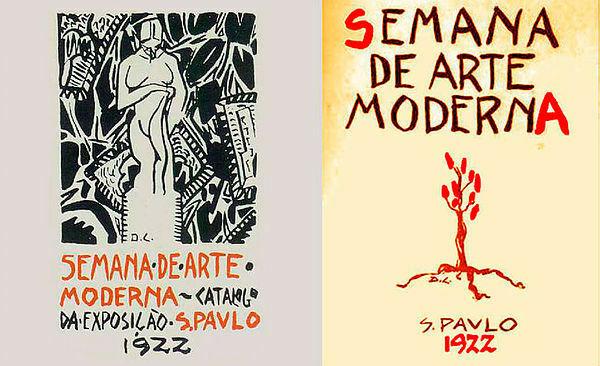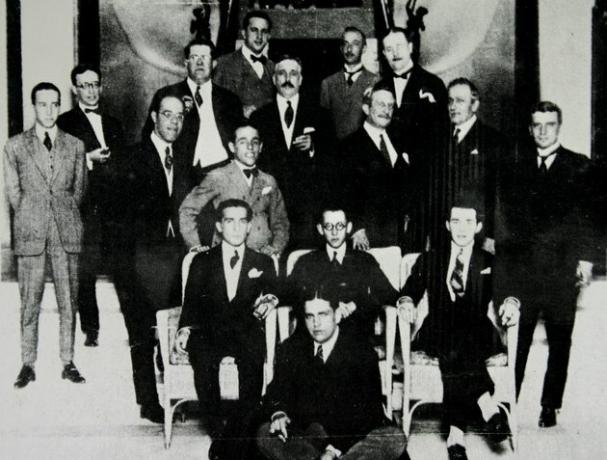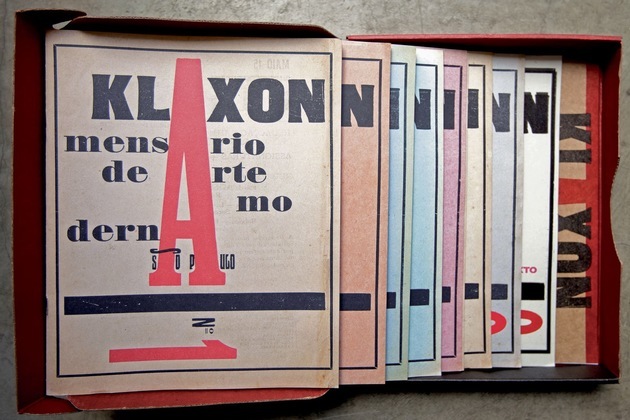THE Modern Art Week it was an artistic-cultural event that took place at the Municipal Theater of São Paulo between February 13th and 18th, 1922.
The event brought together several presentations of dance, music, poetry recitals, exhibition of works - painting and sculpture - and lectures.
The artists involved proposed a new vision of art, based on an innovative aesthetic inspired by European avant-gardes.
Together, they aimed at a social and artistic renewal in the country, which was triggered by the "Week of 22".
The event shocked a large part of the population and brought to light a new vision of artistic processes, as well as the presentation of “more Brazilian” art.
There was a break with academic art, thus inaugurating an aesthetic revolution and the Modernist Movement in Brazil.
Mário de Andrade was one of the central figures and main articulator of the Week of Modern Art in 22. He was alongside other organizers: the writer Oswald de Andrade and the plastic artist Di Cavalcanti.

Features of the Modern Art Week
Since the main intention of these artists was to shock the public and bring to light other ways of feeling, seeing and enjoying art, the characteristics of this moment were:
- Absence of formalism;
- Break with academicism and traditionalism;
- Criticism of the Parnassian model;
- Influence of European artistic vanguards (Futurism, Cubism, Dadaism, Surrealism, Expressionism);
- Appreciation of Brazilian identity and culture;
- Fusion of external influences to Brazilian elements;
- Aesthetic experiments;
- Freedom of expression;
- Approximation of oral language, using colloquial and vulgar language;
- Nationalist and everyday themes.
The Week of 1922: Summary
On the centenary of the country's independence, which took place in 1822, Brazil was going through several social, political and economic changes (advent of industrialization, end of the first war worldwide, etc.).
The need arises to resort to a new aesthetic, and hence the "Modern Art Week".
It was composed of artists, writers, musicians and painters who sought aesthetic innovations. The aim was to create a way to break with the parameters that prevailed in the arts in general.
Most of the artists were descendants of the coffee oligarchies of São Paulo, which together with the farmers of Minas, formed a policy that became known as “Café com Leite”.
This factor was decisive for the realization of the event, since it was supported by the government of Washington Luís, at the time governor of the State of São Paulo.
In addition, most artists, who had financial possibilities to travel and study in Europe, brought to the country several artistic models. Thus, together with Brazilian art, the modernist movement was formed in Brazil.
With this, São Paulo demonstrated (in confrontation with Rio de Janeiro) new horizons and a leading figure in the Brazilian cultural scene.
For Di Cavalcante, the week of art:
It would be a week of literary and artistic scandals, of putting the stirrups in the belly of the little São Paulo bourgeoisie.
That is how, for three days (February 13, 15 and 17), this artistic, political and cultural event brought together irreverent and contesting young artists.
The event was inaugurated with a lecture by writer Graça Aranha: “The Aesthetic Emotion of Modern Art”; followed by musical performances and art exhibitions. The event was packed and it was a relatively quiet night.
On the second day, there was a musical presentation, a lecture by the writer and artist Menotti del Picchia, and the reading of the poem “the frogs” by Manuel Bandeira.
Ronald de Carvalho did the reading, as Bandeira was in a crisis of tuberculosis. In this poem, criticism of Parnassian poetry was severe, which caused public indignation, many boos, barking and neighing sounds.
Finally, on the third day, the theater was emptier. There was a musical performance with a mix of instruments, exhibited by the carioca Villa Lobos.
On that day, the musician took the stage wearing a coat and wearing a shoe on one foot and a slipper on the other. The audience booed thinking it was an outrageous attitude, but later it was explained that the artist had a callus on his foot.
Top Artists

Some artists who participated in the 1922 Modern Art Week:
- Mario de Andrade (1893-1945)
- Oswald de Andrade (1890-1954)
- grace spider (1868-1931)
- Victor Brecheret (1894-1955)
- Plínio Salgado (1895-1975)
- Anita Malfatti (1889-1964)
- Menotti Del Picchia (1892-1988)
- Ronald de Carvalho (1893-1935)
- Guilherme de Almeida (1890-1969)
- Sergio Milliet (1898-1966)
- Hector Villa-Lobos (1887-1959)
- Tácito de Almeida (1889-1940)
- Di Cavalcanti (1897- 1976)
- Guiomar Novaes (1894-1979)
Repercussion of the Week of 22
Criticism of the movement was severe, people were uncomfortable with such performances and failed to understand the new art proposal. The artists involved were even compared to the mentally ill and the insane.
With that, it became clear that the population needed to be prepared for the reception of such artistic models.
Monteiro Lobato was one of the writers who vehemently attacked the Week of 22 actions.
Previously, he had already published an article criticizing the works of Anita Malfatti, in an exhibition of the painter held in 1917.
There are two kinds of artists. One composed of those who see things normally (..) The other species is formed by those who see nature abnormally and they interpret it in the light of ephemeral theories, under the squint suggestion of rebellious schools, which emerged here and there as boils of culture excessive. (...) Although they give themselves as new, precursors of an art to come, nothing is older than abnormal or teratological art: it was born with paranoia and with mystification (...) These considerations are provoked by the exhibition by Ms. Malfatti, where one notices very accentuated tendencies towards a forced aesthetic attitude towards the extravagances of Picasso and company.
Outcomes of the Week of 22
After the Week of Modern Art, considered one of the most important milestones in the cultural history of Brazil, numerous magazines, movements and manifestos were created.
From then on, several groups of artists got together in order to disseminate this new model. Highlights:
- Klaxon Magazine (1922)
- Aesthetics Magazine (1924)
- Pau-Brasil Movement (1924)
- Green-Yellow Movement (1924)
- The Magazine (1925)
- Regionalist Manifesto (1926)
- Purple Earth (1927)
- Other Lands (1927)
- Journal of Anthropophagy (1928)
- Anthropophagic Movement (1928)

We can also cite other cultural developments that were inspired by the ideas of the modernists, such as the Tropicalism and the generation of Lira Paulistana, in the 70s, and even the Bossa nova.
Video about the Modern Art Week
.
